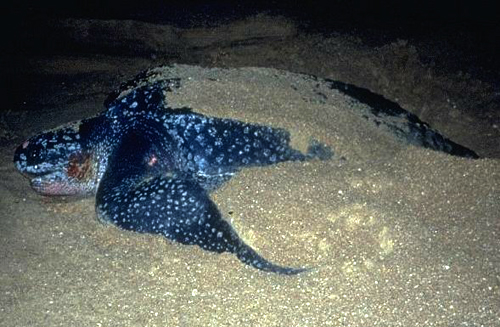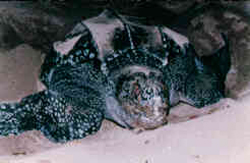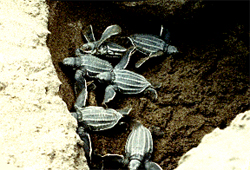|  Leatherbacks, the earth's most ancient and largest living reptile, are one of the most endangered of all sea turtles. They have witnessed the fall of the dinosaurs and the rise of humanity. Their habitat spans the globe from the North Atlantic near the Arctic Circle to the South Pacific around New Zealand. Leatherbacks, the earth's most ancient and largest living reptile, are one of the most endangered of all sea turtles. They have witnessed the fall of the dinosaurs and the rise of humanity. Their habitat spans the globe from the North Atlantic near the Arctic Circle to the South Pacific around New Zealand.
 Click here to donate to this project Click here to donate to this project
The founders of the Costa Rica Leatherback Project are Dr. Frank Paladino and Dr. James Spotila, both passionate sea turtle conservationists. Over the past 11 years, they have watched the rapid decline of the leatherbacks at Playa Grande ("Big Beach"), Costa Rica. The number of nesting females has dropped from about 1,340 per season to approximately 130-140 per year. This decline is the result of over 15 years of almost complete harvest of the eggs laid by returning females and the loss of many nesting beaches to development for hotels, resorts, and private homes.
 According to Dr. Paladino, there has also been a greater than 40% mortality rate in the returning adult population over the last eight years. The scientists obtain this data by fitting the turtles with satellite transmitters and following their migrations. Dr. Paladino and his colleagues report that many leatherbacks disappear as they migrate away from their nesting sites to areas near the Galapagos, Easter Island, and off the coasts of Ecuador. They suspect that long line and gill net fishing kill these turtles. According to Dr. Paladino, there has also been a greater than 40% mortality rate in the returning adult population over the last eight years. The scientists obtain this data by fitting the turtles with satellite transmitters and following their migrations. Dr. Paladino and his colleagues report that many leatherbacks disappear as they migrate away from their nesting sites to areas near the Galapagos, Easter Island, and off the coasts of Ecuador. They suspect that long line and gill net fishing kill these turtles.
 During the nesting season (September to March) the Costa Rica leatherback project conducts nightly census work. Scientists, assisted by a staff of volunteers, patrol the beach and search for turtles. When a nesting turtle is located a small, electronic identification tag called a Passive Integrated Transponder (PIT) is injected into the turtle's shoulder muscle. PIT tags remain in place for the turtle's lifetime and are easily detected with a small handheld scanner. Each turtle has a unique number. This information helps scientists identify the turtles who nest each night, find out how many times each turtle nests during the season, and determine the nesting interval. The data also allows scientists to calculate the population size in areas where the turtles are not observed but the nests can be seen. During the nesting season (September to March) the Costa Rica leatherback project conducts nightly census work. Scientists, assisted by a staff of volunteers, patrol the beach and search for turtles. When a nesting turtle is located a small, electronic identification tag called a Passive Integrated Transponder (PIT) is injected into the turtle's shoulder muscle. PIT tags remain in place for the turtle's lifetime and are easily detected with a small handheld scanner. Each turtle has a unique number. This information helps scientists identify the turtles who nest each night, find out how many times each turtle nests during the season, and determine the nesting interval. The data also allows scientists to calculate the population size in areas where the turtles are not observed but the nests can be seen.
Costa Rica Leatherback Project participants also protect nests from poachers and predators to maximize the number of hatchlings produced. They measure turtles, count eggs, measure the temperature of nests to determine hatchling sex, and record the level of human activity on the beach
 A hatchery project for leatherback eggs is another primary activity at Playa Grande. Participants collect the eggs as the turtles lay them. Then, the eggs are transported to hand dug nests in the hatchery. Nests are the same depth as those made by the turtles. They are placed one metre apart. Some nests have gas and temperature sampling devices in them. Sampling devices are placed between some of the empty nets to measure the control data. Each nest is marked with the identification information of the turtle which laid the eggs, and the number of eggs. After the nest has hatched, the scientists excavate it and calculate the success rate. In the 2003-3 season, 168 clutches of eggs were placed in the hatchery. A hatchery project for leatherback eggs is another primary activity at Playa Grande. Participants collect the eggs as the turtles lay them. Then, the eggs are transported to hand dug nests in the hatchery. Nests are the same depth as those made by the turtles. They are placed one metre apart. Some nests have gas and temperature sampling devices in them. Sampling devices are placed between some of the empty nets to measure the control data. Each nest is marked with the identification information of the turtle which laid the eggs, and the number of eggs. After the nest has hatched, the scientists excavate it and calculate the success rate. In the 2003-3 season, 168 clutches of eggs were placed in the hatchery.
For more information on this project go to: www.Leatherback.org
|


 Click here to donate to this project
Click here to donate to this project 


 According to Dr. Paladino, there has also been a greater than 40% mortality rate in the returning adult population over the last eight years. The scientists obtain this data by fitting the turtles with satellite transmitters and following their migrations. Dr. Paladino and his colleagues report that many leatherbacks disappear as they migrate away from their nesting sites to areas near the Galapagos, Easter Island, and off the coasts of Ecuador. They suspect that long line and gill net fishing kill these turtles.
According to Dr. Paladino, there has also been a greater than 40% mortality rate in the returning adult population over the last eight years. The scientists obtain this data by fitting the turtles with satellite transmitters and following their migrations. Dr. Paladino and his colleagues report that many leatherbacks disappear as they migrate away from their nesting sites to areas near the Galapagos, Easter Island, and off the coasts of Ecuador. They suspect that long line and gill net fishing kill these turtles.  During the nesting season (September to March) the Costa Rica leatherback project conducts nightly census work. Scientists, assisted by a staff of volunteers, patrol the beach and search for turtles. When a nesting turtle is located a small, electronic identification tag called a Passive Integrated Transponder (PIT) is injected into the turtle's shoulder muscle. PIT tags remain in place for the turtle's lifetime and are easily detected with a small handheld scanner. Each turtle has a unique number. This information helps scientists identify the turtles who nest each night, find out how many times each turtle nests during the season, and determine the nesting interval. The data also allows scientists to calculate the population size in areas where the turtles are not observed but the nests can be seen.
During the nesting season (September to March) the Costa Rica leatherback project conducts nightly census work. Scientists, assisted by a staff of volunteers, patrol the beach and search for turtles. When a nesting turtle is located a small, electronic identification tag called a Passive Integrated Transponder (PIT) is injected into the turtle's shoulder muscle. PIT tags remain in place for the turtle's lifetime and are easily detected with a small handheld scanner. Each turtle has a unique number. This information helps scientists identify the turtles who nest each night, find out how many times each turtle nests during the season, and determine the nesting interval. The data also allows scientists to calculate the population size in areas where the turtles are not observed but the nests can be seen.  A hatchery project for leatherback eggs is another primary activity at Playa Grande. Participants collect the eggs as the turtles lay them. Then, the eggs are transported to hand dug nests in the hatchery. Nests are the same depth as those made by the turtles. They are placed one metre apart. Some nests have gas and temperature sampling devices in them. Sampling devices are placed between some of the empty nets to measure the control data. Each nest is marked with the identification information of the turtle which laid the eggs, and the number of eggs. After the nest has hatched, the scientists excavate it and calculate the success rate. In the 2003-3 season, 168 clutches of eggs were placed in the hatchery.
A hatchery project for leatherback eggs is another primary activity at Playa Grande. Participants collect the eggs as the turtles lay them. Then, the eggs are transported to hand dug nests in the hatchery. Nests are the same depth as those made by the turtles. They are placed one metre apart. Some nests have gas and temperature sampling devices in them. Sampling devices are placed between some of the empty nets to measure the control data. Each nest is marked with the identification information of the turtle which laid the eggs, and the number of eggs. After the nest has hatched, the scientists excavate it and calculate the success rate. In the 2003-3 season, 168 clutches of eggs were placed in the hatchery. 





